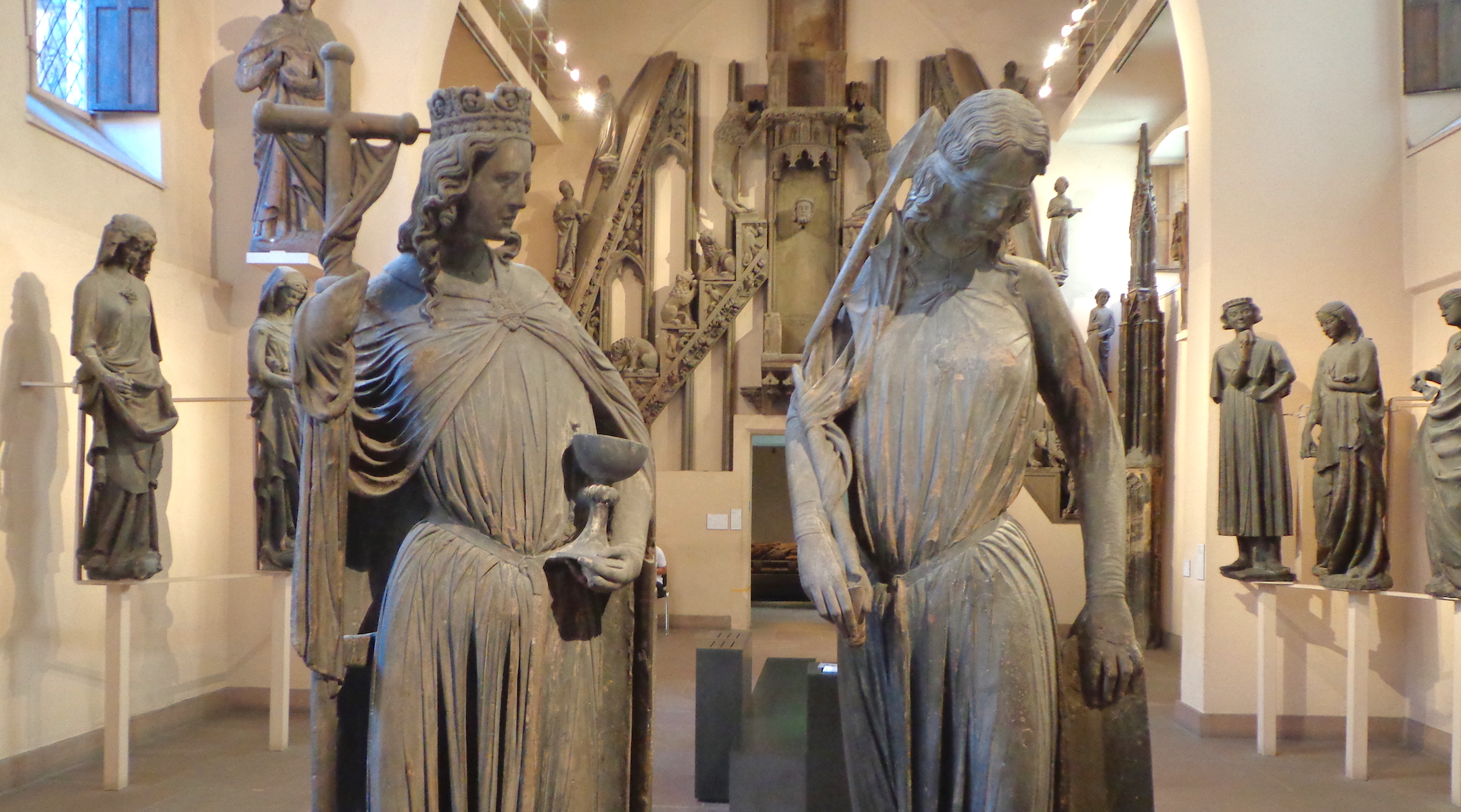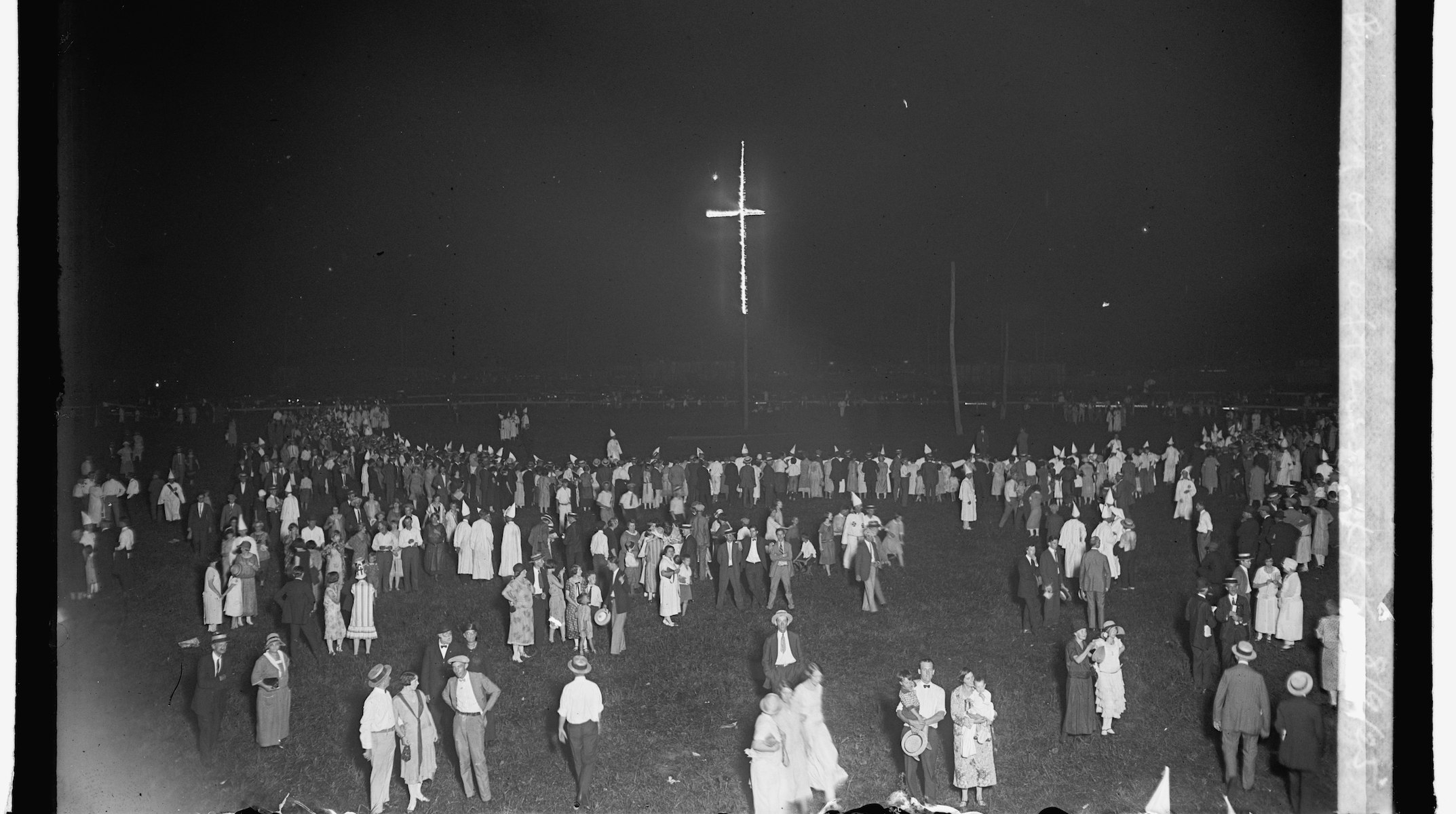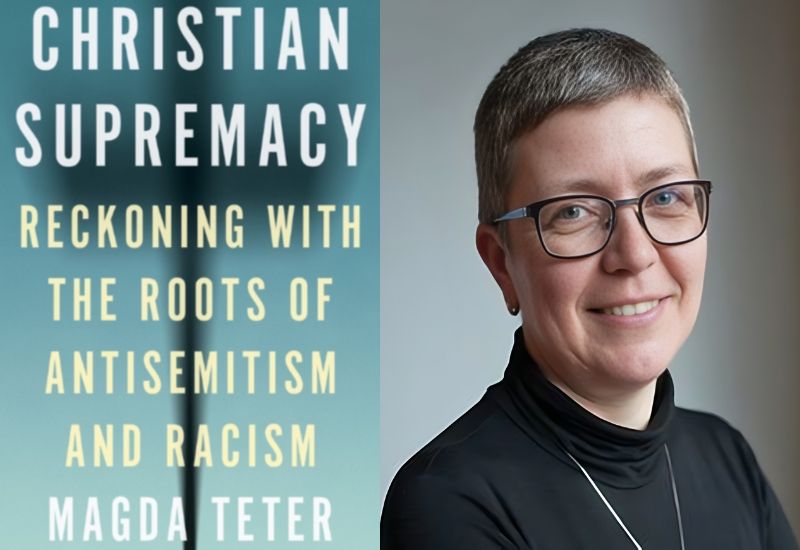(JR) — Magda Teter’s new book, “Christian Supremacy,” begins in Charlottesville, Virginia, on Aug. 11, 2017. Hundreds of white nationalist neo-Nazis who ostensibly gathered to protest the removal of a statue of Confederate general Robert E. Lee from a local park broke into a chant: “Jews will not replace us.”
Other writers and scholars would note how antisemitism shaped white nationalism. But Teter, professor of history and the Shvidler Chair of Judaic Studies at Fordham University, saw something else: how centuries of Christian thought and practice fed the twin evils of antisemitism and racism.
“The ideology espoused by white supremacists in the US and in Europe is rooted in Christian ideas of social and religious hierarchy,” she writes. “These ideas developed, gradually, first in the Mediterranean and Europe in respect to Jews and then in respect to people of color in European colonies and in the US, before returning transformed back to Europe.”
In the book, subtitled “Reckoning with the Roots of Antisemitism and Racism,” she traces this idea from the writings of the early church fathers like Paul the Apostle, though centuries of Catholic and Protestant debates over the status of Jews in Europe, to the hardening of racist attitudes with the rise of the trans-Atlantic slave trade.
Antisemitic laws and theology, she argues, developed within Christianity a “mental habit” of exclusion and dominance that would eventually be applied to people of color up to and including modern times.
Teter is careful to acknowledge the different forms antisemitism and racism have taken, distinguishing between the Jews’ experience of social and legal exclusion and near annihilation, and the enslavement, displacement and ongoing persecution of Black people. And yet, she writes, “that story began with Christianity’s theological relation with Jews and Judaism.”
Teter is previously the author of “Blood Libel: On The Trail of an Antisemitic Myth,” winner of the 2020 National Jewish Book Award. At Fordham, the Catholic university in the Bronx, she is helping assemble what may be the largest repository of artifacts and literature dedicated to the Jewish history of the borough.
We spoke Thursday about how groups like the Proud Boys embrace centuries-old notions of Christian superiority, how “whiteness” became a thing and how she, as a non-Jew raised in Poland, became a Jewish studies scholar.
Our conversation was edited for length and clarity.
Your book was conceived and written during the COVID lockdown. Where did the idea for the book come from?
It’s an accidental project. I’ve been teaching the history of antisemitism for years, and I live in Harlem so questions of race and racism are very stark in my daily life. And since I grew up in Poland, and American history was not something we were taught or studied, I’ve never been satisfied with the various explanations for the strength of antisemitism and history of racism. And as I mentioned in my prologue, I watched the Raoul Peck documentary, “I Am Not Your Negro,” which has a clip with James Baldwin saying that white people have to figure out why they invented the idea of the N-word and must “embrace this stranger that they have maligned so long.” You could also say that the European Christians created the idea of “the Jew” and that sort of caricature had absolutely nothing to do with flesh and blood Jews. I kept noticing these parallels, as an outsider, reading American and African-American history.
I was also thinking about this idea of servitude that was attached to Jews in Christian theology, and then in law.
You write in your book that “Over time, white European Christians branded both Jews and people of color with ‘badges of servitude’ and inferiority.” What do you mean by servitude in this context?
In Christian theology, from the earliest Christian texts, the idea of servitude and slavery is attached to the concept of Jews and Judaism. Paul does it in his Epistles. He uses this quote from the book of Genesis that “the elder shall serve the younger,” which becomes really embedded in Christian theology. It is the Jews, the elder people, who should serve the Christians, the younger people. Later on in medieval theology and canon law, Jews are in a servile position, consigned for their sin of rejecting Jesus to perpetual servitude. So even though Jews were free people and could live mostly where they wanted to live, marry whoever they wanted to marry — nobody was sold and some even had slaves — that idea of Jews as confined to perpetual servitude to Christians created a habit of thinking of Jews as having an inferior social status.
That language became secularized in modern times, and we see the development of the [antisemitic] trope of Jewish power: that they are in places where they shouldn’t be. I worked on fleshing out the parallels between the idea and then legal status of Jewish servitude and the conceptual perception of Black people in servile and inferior positions.
Magda Teter’s new book explores how “white European Christians branded both Jews and people of color with ‘badges of servitude’ and inferiority.” (Chuck Fishman)
What other kinds of parallels did you find between racism and antisemitism?
In the Christian theology, Black people, like Jews, will be seen as cursed by God. Jews were [portrayed as] lazy because they didn’t work physically — they made money and exploited Christians. Black people were [portrayed as] lazy because they were trying to avoid physical labor at the expense of white men. Both people were seen as carnal, both as sexually dangerous, and so on.
I was struck by the fact that the racist turn of Christian supremacy — justifying the enslavement of Black people on theological grounds — is a fairly late development, taking hold in the early modern period when Europeans established slaveholding empires.
That’s right. In the summer of 2020, the summer of George Floyd and Black Lives Matter, we were all thinking about these issues of race and racism and America. And as I was in the middle of writing the article that became the book, I felt that there was a deeper history that needed to be told, and that slavery is not bound by color until the enslavement of Black Africans by Europeans during the colonial expansion of Europe.
After the French Revolution, when Jews were offered “emancipation” in much of Europe, there were deep debates about whether they could be citizens and be entitled to the same rights and protections as Christian citizens of France and England and other countries. How was that debate informed by Christianity?
In pre-modern Europe, there was obviously both a religious and legal framework under which Jews existed. They had their place in a social hierarchy. After the French Revolution, people are creating a new political reality. The idea of equality obviously challenged the social hierarchies that existed, including the idea that Christians were the superior religion. And that begins to play a role on two levels. One is the level of, well, “how can you be equal and be our judges and make decisions about us?” It’s fear of power — political power and political equality. That challenges the habit of thinking that sees Jews as inferior, in servitude and otherwise insolent and arrogant.
The other level comes from Enlightenment scholars who begin to place Jews in the Middle East and in the Holy Land, in Palestine. Jews are no longer seen as European. They are seen as “Oriental,” and they are compared to the non-European religions and practices that these Enlightenment scholars have been studying. Their differences are now also racialized. “They are not like us, they can’t assimilate. They can never be Frenchmen, they can never be Germans.”
And I guess it’s a short step from that to regarding people with dark skin as inferior and subordinate.
That’s right. Enlightenment scholars are also trying to to understand why it is justified to enslave Black Africans and they do it through “scientific” and other means. They classify Africans as inferior intellectually and they create this idea of race.
I began to think about these European politicians and intellectuals in terms of creating their identities, and what I ended up arguing is what we saw in Charlottesville, what we’re seeing in Europe. It’s not necessarily just about hate, but it’s about exclusion and rejection of Jews and people of color from equality, from citizenship.
And the common thread here is that whiteness and Christianity become inseparable. You write that “freedom and liberty now came to be linked not only to Christianity, but to whiteness, and servitude and enslavement to blackness.”
That’s right. White Christian “liberty” becomes embedded and embodied in law.
Did you see any pitfalls in drawing parallels between the Black and Jewish experiences? I am thinking of those in either community who might say, “How dare you compare our suffering to theirs!”
Yes, I was tempered. I think what some call “comparative victimhood” has paralyzed conversations about this subject, and I kept it in my mind all the time. What I hope comes through is that there’s incredible value in a comparative approach. Coming from Jewish studies as my primary field, the comparison with the Black experience gave me clarity on the nature of antisemitism as well as on the nature of the Jewish experience, and vice versa: The Jewish experience can also give clarity to some of the aspects of anti-Black racism.
What’s an example?
So, for instance, questions like, “Are Jews white? Are they not white? When did they become white?” That’s a whole genre of scholarship. And when you look at it through the lens of law and ideology, you begin to see that from a legal perspective, Jews were considered white in the United States because they could immigrate and they could be naturalized according to law. They did not have to go to court to become American. Their rights to vote were not challenged. There was discrimination, they couldn’t stay in hotels and in some places they couldn’t find employment, but by law, they were considered citizens. The debate about the whiteness of Jews is creating a fog of misunderstanding.
Black Americans were targeted by specific legal statutes from the very beginning in the Constitution and then in naturalization law and so on. And then there was the backlash even after the Civil War to the 13th, 14th and 15th amendments [aimed at establishing political equality for Americans of all races].

Statues at the Strasbourg Cathedral depict Ecclesia and Synagoga, representing the triumph of the church, at left, and the servitude of Judaism, which is represented by a blindfolded figure, drooping and carrying a broken lance. (Edelseider/Wikimedia Commons)
How much do modern-day white supremacists, like the Oath Keepers or the Proud Boys, see themselves as Christian? Or is this a kind of white supremacy that doesn’t name itself Christian but doesn’t even realize how many of its ideas are based in theology?
I think they might not be conscious of this legacy, but neo-Nazis take from the legacy of the Nazis who themselves were not thinking of themselves as Christian necessarily. But what I argue in the book is that white Christian supremacy becomes white supremacy. It never discards the Christian sense of domination and superiority that emerges from its early relationship with Jews and Judaism.
In the United States, Black people serve as contrast figures to whiteness, in the law and in the culture. You cannot have whiteness without Blackness. For Christians, Jews serve as that contrast figure. Consciously or unconsciously, the Proud Boys are embracing that. They talk of “God-given” freedoms for white people. That is the Christian legacy.
You said that the Nazis didn’t necessarily see themselves as a Christian movement. But I must ask, even though it is not the scope of your book, was the Holocaust a culmination of white Christian supremacy? Because I think many Christian theologians would want to say that Nazism was godless, and a perversion of the true faith.
I’ll say that when exclusionary ideology is coupled with the power of the state, that’s where it can lead.
In the years since the Holocaust especially, there have been many efforts by Christian leaders to address the ideological failings of the past. You write about Nostra Aetate, the 1965 declaration by the Catholic Church absolving Jews of collective guilt in the death of Jesus and some Protestant documents of contrition. But I got the feeling you were disappointed that many denominations haven’t gone far enough in reckoning with the past.
There was a sort of a moral sense that something needs to be addressed after the Holocaust. But then it is not fully addressed. I don’t think anybody has addressed the issue of power — the roots of hate, yes, but not the dynamics of power. We’ll see where the book goes, but maybe theologians will begin to grapple with this legacy of superiority and domination, and the way hierarchical habits of thinking have been developed through theology and through religious culture.
What other impact do you hope the book may have?
White supremacy is very much in the air. We need to speak up against it, and make connections and allyships. I hope that maybe because the book deals with law and power, it may create bridges among people who care about “We the People” as a vision of people who are diverse, respectful and equal, and not the exclusionary vision offered by white and Christian supremacy.

A cross burns at a Ku Klux Klan rally on Aug. 8, 1925. (National Photo Company Collection)
I’d love to talk about your background. You’re not Jewish but you are chair of Jewish Studies at Fordham, a Catholic university. What drew you to the study of Judaism and the Jews?
I grew up in Poland with a father who from the time I was a little girl would point out to me that there had been Jews in Poland. We would drive through the countryside, and he’d say, “This used to be a Jewish town and there used to be a synagogue and there was the Jewish cemetery.” I grew up being very conscious of the past’s presence and this kind of stark absence of Jews in Poland, where in the 1970s when I grew up Jewish history was taboo.
As soon as Jewish books on Jewish subjects began to be published, including those that dealt with antisemitism, we would read it together. We would talk about it. He wouldn’t just shift the destruction and murder of Jews in Poland on to the Nazis.
There was no Jewish studies program in Poland when I was applying to universities, so I studied Hebrew in Israel, and then studied Yiddish in New York at YIVO. I came to Columbia University to get my PhD in Jewish history and my career went in the direction it did. I was a professor of history and director of the Jewish and Israel studies program at Wesleyan University. I came to Fordham eight years ago and created a program in Jewish studies.
Your previous book was about the blood libel, the historic canard that Jews murdered Christian children to use their blood. This one’s about antisemitism. I don’t want to presume, but is your interest in these subjects in any way an act of contrition?
I grew up in a very secular household. I did not grow up Catholic. But I think growing up in Poland made me very, very aware of antisemitism and the history of antisemitism. I got my PhD from Columbia University in Jewish history, which did not emphasize Jewish suffering, but Jewish life, and I have studied Jewish life and teach about Jewish life — not just about Jewish suffering.
However, in the last few years, antisemitism has certainly been on the minds of many of us. I also am committed to the idea of shared history, and therefore all my scholarship, as much as it is about Jews, it is also about the church and Poland and the law. Jews are an integral part of that history and culture. And, as such, I’m committed to that, to teaching about the vibrancy of Jewish life as much as the dynamics of what made that life difficult over the centuries.
The views and opinions expressed in this article are those of the author and do not necessarily reflect the views of JR or its parent company, 70 Faces Media.




